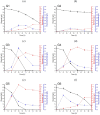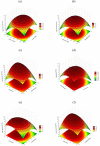Bioconversion of waste glycerol into viscosinamide by Pseudomonas fluorescens DR54 and its activity evaluation
- PMID: 38233450
- PMCID: PMC10794706
- DOI: 10.1038/s41598-024-51179-4
Bioconversion of waste glycerol into viscosinamide by Pseudomonas fluorescens DR54 and its activity evaluation
Abstract
Lipopeptides, derived from microorganisms, are promising surface-active compounds known as biosurfactants. However, the high production costs of biosurfactants, associated with expensive culture media and purification processes, limit widespread industrial application. To enhance the sustainability of biosurfactant production, researchers have explored cost-effective substrates. In this study, crude glycerol was evaluated as a promising and economical carbon source in viscosinamide production by Pseudomonas fluorescens DR54. Optimization studies using the Box - Behnken design and response surface methodology were performed. Optimal conditions for viscosinamide production including glycerol 70.8 g/L, leucine 2.7 g/L, phosphate 3.7 g/L, and urea 9.3 g/L were identified. Yield of viscosinamide production, performed under optimal conditions, reached 7.18 ± 0.17 g/L. Preliminary characterization of viscosinamide involved the measurement of surface tension. The critical micelle concentration of lipopeptide was determined to be 5 mg/L. Furthermore, the interactions between the viscosinamide and lipase from Candida rugosa (CRL) were investigated by evaluating the impact of viscosinamide on lipase activity and measuring circular dichroism. It was observed that the α-helicity of CRL increases with increasing viscosinamide concentration, while the random coil structure decreases.
© 2024. The Author(s).
Conflict of interest statement
The authors declare no competing interests.
Figures






Similar articles
-
Viscosinamide, a new cyclic depsipeptide with surfactant and antifungal properties produced by Pseudomonas fluorescens DR54.J Appl Microbiol. 1999 Jul;87(1):80-90. doi: 10.1046/j.1365-2672.1999.00798.x. J Appl Microbiol. 1999. PMID: 10432590
-
High-yield expression of extracellular lipase from Yarrowia lipolytica and its interactions with lipopeptide biosurfactants: A biophysical approach.Arch Biochem Biophys. 2020 Aug 15;689:108475. doi: 10.1016/j.abb.2020.108475. Epub 2020 Jun 23. Arch Biochem Biophys. 2020. PMID: 32585312
-
High-throughput optimization of medium components and culture conditions for the efficient production of a lipopeptide pseudofactin by Pseudomonas fluorescens BD5.Microb Cell Fact. 2018 Aug 4;17(1):121. doi: 10.1186/s12934-018-0968-x. Microb Cell Fact. 2018. PMID: 30077177 Free PMC article.
-
Bacillus licheniformis: The unexplored alternative for the anaerobic production of lipopeptide biosurfactants?Biotechnol Adv. 2022 Nov;60:108013. doi: 10.1016/j.biotechadv.2022.108013. Epub 2022 Jun 22. Biotechnol Adv. 2022. PMID: 35752271 Review.
-
Biosurfactant: A new frontier for greener technology and environmental sustainability.Ecotoxicol Environ Saf. 2019 Nov 30;184:109607. doi: 10.1016/j.ecoenv.2019.109607. Epub 2019 Sep 7. Ecotoxicol Environ Saf. 2019. PMID: 31505408 Review.
Cited by
-
Heterologous expression and enzymatic properties of lipase from Mucor circinelloides.Sci Rep. 2025 Mar 29;15(1):10871. doi: 10.1038/s41598-025-93938-x. Sci Rep. 2025. PMID: 40157944 Free PMC article.
References
-
- Deepika KV, Kalam S, Ramu Sridhar P, Podile AR, Bramhachari PV. Optimization of rhamnolipid biosurfactant production by mangrove sediment bacterium Pseudomonas aeruginosa KVD-HR42 using response surface methodology. Biocatal. Agric. Biotechnol. 2016;5:38–47. doi: 10.1016/j.bcab.2015.11.006. - DOI
MeSH terms
Substances
Grants and funding
LinkOut - more resources
Full Text Sources

